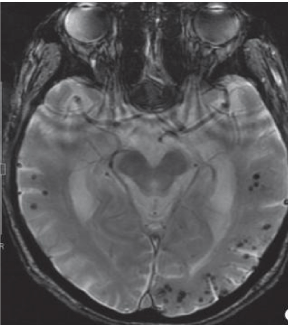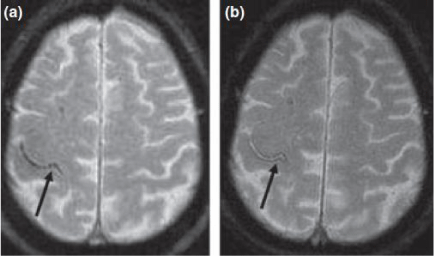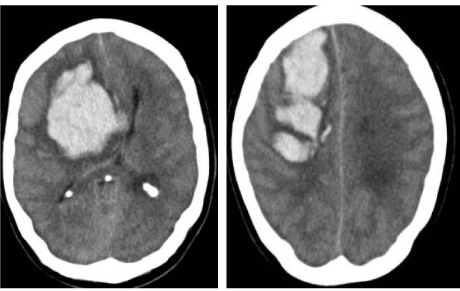
Mini Review
Austin J Cerebrovasc Dis & Stroke. 2015;2(1): 1033.
TIA-like Presentations of Cerebral Amyloid Angiopathy
Galea B and Pullicino P*
1University of Malta, UK
2University of Kent, Canterbury, UK
*Corresponding author: Pullicino P, University of Kent, Canterbury, UK
Received: April 01, 2015; Accepted: May 15, 2015; Published: May 20, 2015
Abstract
Transient focal neurological episodes (TFNEs ) are transient ischemic attack (TIA)-like episodes that may occur in patients with cerebral amyloid angiopathy (CAA). The duration of TFNEs is typically similar to TIAs with most symptoms resolving in 24 hours. Symptoms, similar to those of TIA’s include sensory or visual disturbances, motor weakness and language impairment but headache and ictal symptoms also occur. TFNEs had a more gradual onset and tend to spread slowly to contiguous body parts like a migraine aura. TFNEs may occur repeatedly throughout the day and attacks may continue over several months. TFNEs are typically associated with focal cortical subarachnoid hemorrhage or with focal cortical superficial siderosis. They may also be seen in patient with CAA-related lobar hemorrhage, microhemorrhage or leukoencephalopathy. The clinical picture associated with the transient focal brain edema seen in CAA may also be a TFNE. Migraine prophylactic agents such as verapamil and topiramate may be useful in stopping frequent recurrent TFNEs. TFNEs are an under-recognized cause of apparent TIAs. It is important to keep TFNEs in the differential diagnosis when a patient presents with a presumed TIA as thrombolysis or anticoagulation is relatively contraindicated in CAA. Gradient echo MRI should be performed to exclude microhemorrhages when TFNEs are suspected.
Introduction
Clinicians most frequently associate cerebral amyloid angiopathy (CAA) with intracerebral hemorrhage or with a clinical picture of vascular cognitive impairment [1]. There have however, been increasing clinical reports documenting that CAA may cause a variety of clinical neurological manifestations in the acute setting [2]. Although these phenomena are superficially similar to TIAs and may be mistaken for them, they have distinct clinical time profiles and progressions that separate them from TIAs clinically. They appear to be caused by different manifestations of the complications of CAA and are now known as transient focal neurological episodes (TFNE) [2,3]. CAA frequency increases with age with approximately 50 % of individuals over the age of 75 being affected. The exact cause of CAA remains uncertain however increased production and/or decreased breakdown of amyloid proteins may have a role. CAA predominantly affects occipital regions of the brain followed by frontal and temporal areas. Cerebellar vessels are less commonly affected [3]. The Boston criteria are the current standard criteria for diagnosis of CAA. In this review, we attempt to classify and describe the different causes of TFNEs in CAA.
Clinical manifestations of TFNEs
TFNEs include all neurological phenomena that may be otherwise attributed to TIA’s as well as other atypical symptoms that are specific to TNFEs [1]. The duration of TFNEs is typically similar to Transient ischemic attacks (TIA’s) with most symptoms resolving before 24 hours. Some cases of TFNEs have been reported to occur for longer but tend to resolve eventually unlike major cerebrovascular accidents. Symptoms similar to those of TIA’s include sensory disturbances, motor weakness, visual disturbances and language impairment. Atypical symptoms include headache and ictal symptoms [2,3].
TFNEs vary from TIA’s in that symptoms often spread to contiguous body parts much like migraine attacks [3]. TFNE’s also have a more gradual onset unlike TIA’s which often have an abrupt onset. TFNEs are also more likely to occur multiple times during the day unlike TIA’s which usually happen in single episodes or if multiple usually days apart [2,3]. TFNEs may occur multiple times a day, over several months and be a very intrusive symptom for the patient [4]. The typical presentation of a TFNE is of parasthesias involving one or more limbs that spread to involve contiguous areas of that same limb. The spread is gradual and progresses at a rate similar to the spread of a migraine aura. A TFNE may resolve partially or completely before recurring again later on during the day.
TFNEs with cerebral microhemorrhage
Cerebral microhemorrhage that occur as part of CAA may be a cause of TFNEs [5,6]. Microhemorrhages are visualised in 47.4% of patients with CAA confirmed on pathology. 16.5% – 32 % of Alzheimer’s dementia patients had microhemorrhage visualised on T2 gradient-echo MRI which was higher than the 5%-6% in the general population [7-10]. 78 % of Alzheimer’s dementia and/or mild cognitive impairment had microhemorrhages visualized on 7 Tesla MRI [5].

Figure 1: Multiple bilateral microhemorrhages in a lobar distribution [8].

Figure 2: a) Right rolandic sulcus subarachnoid hemorrhage on T2-Gradient
Echo MRI b) Conversion of subarachnoid bleed to CSS 8 months later on T2-
Gradient Echo [8] c) CSS in left parietal lobe on T2- Gradient echo in a patient
presenting with a transient aphasia and right motor deficit [26].

Figure 3: Intracerebral hemorrhage in a patient with CAA confirmed using
Boston criteria. (two separate axial planes from same image) [1,15].
Risk for eventual conversion to lobar intracerebral hemorrhage (ICH) is significantly increased at the sites of microhemorrhage. The risk for microhemorrhage is higher in local areas of confirmed CAA and is directly proportional to the density of amyloid deposition in blood vessels. Increasing numbers of microhemorrhages in a localised area may be suggestive of a future ICH so this can be used as a predictive tool. While most cerebral microhemorrhages are usually asymptomatic, microhemorrhages were associated with TFNE’s in several case studies [11,7-10].
TFNEs with focal cortical subarachnoid hemorrhage and superficial cortical siderosis
The most frequent cause for TFNE’s in CAA is focal cortical subarachnoid hemorrhage with resulting Cortical Superficial Siderosis (CSS) [12]. In CAA, subarachnoid hemorrhages typically occur in a focal convexity pattern along brain areas with a high CAA density [13]. Eventual conversion to superficial siderosis occurs after blood products are cleared from CSF spaces [14]. CSS can be defined as hemosiderin deposits in the subpial space that occur after repeated bleeding into the subarachnoid space. CAA-mediated subarachnoid hemorrhage may present with TIA-like symptoms as well as headache and ictal symptoms [15,16].
CSS occurs in up to 61% of pathologically confirmed cases of CAA and increases the risk for lobar ICH significantly [12,17]. Even though CSS occurs mainly in areas where previous microhemorrhages were present, it generally occurs in patients with CAA with a lower microhemorrhage overall burden [13]. CSS associated with CAA may also be found in Alzheimer’s Dementia and/or mild cognitive impairment patients who have a higher prevalence of CSS when compared to the general population. Current Boston Criteria for diagnosis of CAA does not include subarachnoid hemorrhage [6,18].
15 % of patients with CAA experienced TFNEs at some point in one multicenter cohort study. Patients with CAA and evidence of CSS were more likely to experience TFNEs when compared to CAA patients with no evidence of subarachnoid hemorrhage or CSS (50% vs. 19%). 50 % of TFNE patients experienced subsequent ICH over a median period of 14 months [1,2].
TFNEs associated with intracerebral hemorrhage
ICH is a known complication of CAA. The Helsinki ICH study, using the SMASH-U pathogenic classification for ICH, found that 20% of ICHs occurred in patients with CAA in cortical areas that had higher amyloid angiopathy volume [19]. CAA is the second most frequent cause of ICH after hypertensive vasculopathy. The incidence of CAA related ICH has increased overall and this is most likely due to increasingly aging populations, in which CAA is prelevant [20,21].
ICH in CAA patients typically follows a lobar distribution rather than affecting deep structures of the brain as amyloid is deposited preferentially in meningeal and cortical blood vessels. Even though a significant proportion of ICH symptoms never resolve, CAAmediated ICH has been implicated as a cause for TFNE’s with complete resolution of symptoms in these instances [19,20-22].
TFNEs with transient focal brain edema in CAA
Apart from hemorrhagic events, CAA is also associated with chronic dysregulated blood flow to specific arterial territories. These result in a transient focal white matter edema-like change in areas that are most hypoperfused on MRI [23]. These white matter changes exert a variable degree of mass effect but are not enhanced by contrast. These lesions tend to give symptoms spreading gradually to contiguous body parts. The role of steroids in such lesions is still to be determined.
TFNEs with leukoencephalopathy
Leukoencephalopathy volume is directly related to CAA volume and tends to occur predominately in the frontal and parietal lobes first (70 % of all patients) followed by temporal and occipital regions (15% and 10 %) [4,24]. Leukoencephalopathy is associated with an increased risk of subsequent ICH in the areas most heavily affected. This finding suggests that ICH in CAA may occur as a result of two separate but related complications of CAA (dysregulated blood flow and increased susceptibly of hemorrhage from blood vessels with amyloid deposits) [4,24].
Several TIA-like episodes in known CAA patients had no evidence of overt pathology on imaging (subarachnoid hemorrhage, CSS or ICH) but did have a variable degree of leukoencephalopathy. This finding suggests that these white matter oedema like changes could be another possible cause for TFNEs in CAA [23,4,24].
Conclusion
CAA mediated TFNEs are an under-recognized cause of acute neurological symptoms. It is important to keep TFNEs as part of the differential diagnosis when a patient presents with a presumed TIA. The features distinguishing TIA’s from TFNEs should always be sought using appropriate history taking, clinical examination and specific imaging.
Thrombolysis using IV-tPA or oral anticoagulation has been reported in patients with CAA-related TFNEs due to misdiagnosis as TIA[14,25]. Patients with TFNEs treated with thrombolytic therapy or anticoagulation were more likely to develop ICH when compared to those who did not receive therapy [11]. This finding questions the safety of the usage of anticoagulation/thrombolytic therapy in patients with TIA-like symptoms without prior exclusion of CAAmediated subarachnoid hemorrhage using specific blood sensitive imaging such as T2-gradient echo MRI [14,11,25].
Recent case reports suggest that agents used in migraine prophylaxis (verapamil or topirimate) may have a role in treating frequent recurrent TFNEs that persist over weeks or months and do not resolve spontaneously [4]. In TFNEs caused by focal lobar edema, the role of steroids in the acute phase of management still needs to be evaluated.
References
- Maia LF, Mackenzie IR, Feldman HH. Clinical phenotypes of Cerebral Amyloid Angiopathy. J Neurol Sci. 2007; 257: 23-30.
- Charidimou A, Peeters A, Fox Z, Gregoire SM, Vandermeeren Y, Laloux P, et al. Spectrum of Transient Focal Neurological Episodes in Cerebral Amyloid Angiopathy. Stroke. 2012; 43: 2324-2330.
- Illsley A, Ramadan H. Cerebral amyloid angiopathy: a transient ischaemic attack mimic. Clin Med. 2014; 14: 255-259.
- Paterson RW, Uchino K, Emsley HC, Pullicino P. Recurrent stereotyped episodes in cerebral amyloid angiopathy: response to migraine prophylaxis in two patients. Cerebrovasc Dis Extra. 2013; 3: 81-84.
- Brundel M, Heringa SM, de Bresser J, Koek HL, Zwanenburg JJ, Jaap Kappelle L, et al. High prevalence of cerebral microbleeds at 7Tesla MRI in patients with early Alzheimer's disease. J Alzheimers Dis. 2012; 31: 259-263.
- Shoamanesh A, Martinez-Ramirez S, Oliveira-Filho J, Reijmer Y, Falcone GJ, Ayres A, et al. Interrelationship of superficial siderosis and microbleeds in cerebral amyloid angiopathy. Neurology. 2014; 83: 1838-1843.
- Dierksen GA, Skehan ME, Khan MA, Jeng J, Nandigam RN, Becker JA, et al. Spatial relation between microbleeds and amyloid deposits in amyloid angiopathy. Ann Neurol. 2010; 68: 545-548.
- Yates PA, Sirisriro R, Villemagne VL, Farquharson S, Masters CL, Rowe CC; AIBL Research Group. Cerebral microhemorrhage and brain β-amyloid in aging and Alzheimer disease. Neurology. 2011; 77: 48-54.
- van Etten E1, Auriel E, Haley KE, Ayres AM, Vashkevich A, Schwab KM, et al. Incidence of symptomatic hemorrhage in patients with lobar microbleeds. Stroke. 2014; 45: 2280-2285.
- Gurol ME, Dierksen G, Betensky R, Gidicsin C, Halpin A, Becker A, et al. Predicting sites of new hemorrhage with amyloid imaging in cerebral amyloid angiopathy. Neurology. 2012; 79: 320-326.
- Charidimou1 A, Baron JC, Werring DJ. Transient focal neurological episodes, cerebral amyloid angiopathy, and intracerebral hemorrhage risk- looking beyond TIAs. Int J Stroke. 2013; 8: 105–108.
- Linn J, Halpin A, Demaerel P, Ruhland J, Giese AD, Dichgans M, et al. Prevalence of superficial siderosis in patients with cerebral amyloid angiopathy. Neurology. 2010; 74: 1346-1350.
- Apoil M, Cogez J, Dubuc L, Bataille M, de la Sayette V, Touzé E, et al. Focal Cortical Subarachnoid Hemorrhage Revealed by Recurrent Paresthesias- A Clinico-Radiological Syndrome Strongly Associated with Cerebral Amyloid Angiopathy. Cerebrovasc Dis. 2013; 36: 139–144.
- Gregory Youngnam Chang. Cerebral amyloid angiopathy presenting as a sequential cheiro-oral syndrome. Neurology Asia. 2014; 19: 317 – 318.
- Raposo N, Viguier A, Cuvinciuc V, Calviere L, Cognard C, Bonneville F, et al. Cortical subarachnoid hemmorhage in the elderly- a recurrent event probably related to cerebral amyloid angiopathy. Eur J Neurol. 2011; 18: 597–603.
- Brunot S, Osseby GV, Rouaud O, Kazemi A, Ricolfi F, Couvreur G, et al. Transient Ischaemic Attack Mimics Revealing Focal Subarachnoid Hemmorhage. Cerebrovasc Dis. 2010; 30: 597–601.
- Charidimou A, Peeters AP, Jäger R, Fox Z, Vandermeeren Y, Laloux P, et al. Cortical superficial siderosis and intracerebral hemorrhage risk in cerebral amyloid angiopathy. Neurology. 2013; 81: 1666-1673.
- Wollenweber FA, Buerger K, Mueller C, Ertl-Wagner B, Malik R, Dichgans M, et al. Prevalence of cortical superficial siderosis in patients with cognitive impairment. J Neurol. 2014; 261: 277-282.
- Meretoja A, Strbian D, Putaala J, Curtze S, Haapaniemi E, Mustanoja S, et al. SMASH-U: a proposal for etiologic classification of intracerebral hemorrhage. Stroke. 2012; 43: 2592-2597.
- Linn J, Wollenweber FA, Lummel N, Bochmann K, Pfefferkorn T, Gschwendtner A, et al. Superficial siderosis is a warning sign for future intracranial hemorrhage. J Neurol. 2013; 260: 176-181.
- Béjot Y, Cordonnier C, Durier J, Aboa-Eboulé C, Rouaud O, Giroud M, et al. Intracerebral haemorrhage profiles are changing: results from the Dijon population-based study. Brain. 2013; 136: 658-664.
- Samarasekera N, Smith C, Al-Shahi Salman R. The association between cerebral amyloid angiopathy and intracerebral haemorrhage: systematic review and meta-analysis. J Neurol Neurosurg Psychiatry. 2012; 83: 275-281.
- Cano LM, Martínez-Yélamos S, Majós C, Albertí MA, Boluda S, Velasco R, et al. Reversible acute leukoencephalopathy as a form of presentation in cerebral amyloid angiopathy. J Neurol Sci. 2010; 288: 190–193.
- Savoiardo M, Erbetta A, Di Francesco JC, Brioschi M, Silani V, Falini A, et al. Cerebral amyloid angiopathy-related inflammation: an emerging disease. Neuroradiol J. 2011; 24: 253-257.
- Charidimou A, Baron JC, Werring DJ. Transient focal neurological episodes, cerebral amyloid angiopathy, and intracerebral hemorrhage risk: looking beyond TIAs. Int J Stroke. 2013; 8: 105-108.
- Feldman HH, Maia LF, Mackenzie IR, Forster BB, Martzke J, Woolfenden A. Superficial siderosis: a potential diagnostic marker of cerebral amyloid angiopathy in Alzheimer disease. Stroke. 2008; 39: 2894-2897.